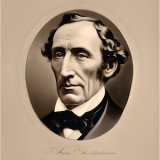Under the Willow-Tree
"Under the Willow-Tree" is a sentimental tale by renowned author Hans Christian Andersen. This children's novel portrays the story of Knud, a gardener's boy who falls in love with a girl named Joanna. They play together under a willow tree, and their friendship grows into love. But when Joanna is sent off to school and eventually marries another man, Knud is devastated. His heartache, however, propels him to travel, encounter new experiences, and learn about life and love. The narrative emphasizes the impermanence of romantic love and the possibilities for self-growth and self-discovery that come from enduring sorrow.
Genre: Children
Genre: Children
- 24 Views
The region round the little town of Kjoge is very bleak and cold. The town lies on the sea shore, which is always beautiful; but here it might be more beautiful than it is, for on every side the fields are flat, and it is a long way to the forest. But when persons reside in a place and get used to it, they can always find something beautiful in it,--something for which they long, even in the most charming spot in the world which is not home. It must be owned that there are in the outskirts of the town some humble gardens on the banks of a little stream that runs on towards the sea, and in summer these gardens look very pretty. Such indeed was the opinion of two little children, whose parents were neighbors, and who played in these gardens, and forced their way from one garden to the other through the gooseberry-bushes that divided them. In one of the gardens grew an elder-tree, and in the other an old willow, under which the children were very fond of playing. They had permission to do so, although the tree stood close by the stream, and they might easily have fallen into the water; but the eye of God watches over the little ones, otherwise they would never be safe. At the same time, these children were very careful not to go too near the water; indeed, the boy was so afraid of it, that in the summer, while the other children were splashing about in the sea, nothing could entice him to join them. They jeered and laughed at him, and he was obliged to bear it all as patiently as he could. Once the neighbor's little girl, Joanna, dreamed that she was sailing in a boat, and the boy--Knud was his name--waded out in the water to join her, and the water came up to his neck, and at last closed over his head, and in a moment he had disappeared. When little Knud heard this dream, it seemed as if he could not bear the mocking and jeering again; how could he dare to go into the water now, after Joanna's dream! He never would do it, for this dream always satisfied him. The parents of these children, who were poor, often sat together while Knud and Joanna played in the gardens or in the road. Along this road--a row of willow-trees had been planted to separate it from a ditch on one side of it. They were not very handsome trees, for the tops had been cut off; however, they were intended for use, and not for show. The old willow-tree in the garden was much handsomer, and therefore the children were very fond of sitting under it. The town had a large market-place; and at the fair-time there would be whole rows, like streets, of tents and booths containing silks and ribbons, and toys and cakes, and everything that could be wished for. There were crowds of people, and sometimes the weather would be rainy, and splash with moisture the woollen jackets of the peasants; but it did not destroy the beautiful fragrance of the honey-cakes and gingerbread with which one booth was filled; and the best of it was, that the man who sold these cakes always lodged during the fair-time with little Knud's parents. So every now and then he had a present of gingerbread, and of course Joanna always had a share. And, more delightful still, the gingerbread seller knew all sorts of things to tell and could even relate stories about his own gingerbread. So one evening he told them a story that made such a deep impression on the children that they never forgot it; and therefore I think we may as well hear it too, for it is not very long. "Once upon a time," said he, "there lay on my counter two gingerbread cakes, one in the shape of a man wearing a hat, the other of a maiden without a bonnet. Their faces were on the side that was uppermost, for on the other side they looked very different. Most people have a best side to their characters, which they take care to show to the world. On the left, just where the heart is, the gingerbread man had an almond stuck in to represent it, but the maiden was honey cake all over. They were placed on the counter as samples, and after lying there a long time they at last fell in love with each other; but neither of them spoke of it to the other, as they should have done if they expected anything to follow. 'He is a man, he ought to speak the first word,' thought the gingerbread maiden; but she felt quite happy--she was sure that her love was returned. But his thoughts were far more ambitious, as the thoughts of a man often are. He dreamed that he was a real street boy, that he possessed four real pennies, and that he had bought the gingerbread lady, and ate her up. And so they lay on the counter for days and weeks, till they grew hard and dry; but the thoughts of the maiden became ever more tender and womanly. 'Ah well, it is enough for me that I have been able to live on the same counter with him,' said she one day; when suddenly, 'crack,' and she broke in two. 'Ah,' said the gingerbread man to himself, 'if she had only known of my love, she would have kept together a little longer.' And here they both are, and that is their history," said the cake man. "You think the history of their lives and their silent love, which never came to anything, very remarkable; and there they are for you." So saying, he gave Joanna the gingerbread man, who was still quite whole--and to Knud the broken maiden; but the children had been so much impressed by the story, that they had not the heart to eat the lovers up. The next day they went into the churchyard, and took the two cake figures with them, and sat down under the church wall, which was covered with luxuriant ivy in summer and winter, and looked as if hung with rich tapestry. They stuck up the two gingerbread figures in the sunshine among the green leaves, and then told the story, and all about the silent love which came to nothing, to a group of children. They called it, "love," because the story was so lovely, and the other children had the same opinion. But when they turned to look at the gingerbread pair, the broken maiden was gone! A great boy, out of wickedness, had eaten her up. At first the
Translation
Translate and read this book in other languages:
Select another language:
- - Select -
- 简体中文 (Chinese - Simplified)
- 繁體中文 (Chinese - Traditional)
- Español (Spanish)
- Esperanto (Esperanto)
- 日本語 (Japanese)
- Português (Portuguese)
- Deutsch (German)
- العربية (Arabic)
- Français (French)
- Русский (Russian)
- ಕನ್ನಡ (Kannada)
- 한국어 (Korean)
- עברית (Hebrew)
- Gaeilge (Irish)
- Українська (Ukrainian)
- اردو (Urdu)
- Magyar (Hungarian)
- मानक हिन्दी (Hindi)
- Indonesia (Indonesian)
- Italiano (Italian)
- தமிழ் (Tamil)
- Türkçe (Turkish)
- తెలుగు (Telugu)
- ภาษาไทย (Thai)
- Tiếng Việt (Vietnamese)
- Čeština (Czech)
- Polski (Polish)
- Bahasa Indonesia (Indonesian)
- Românește (Romanian)
- Nederlands (Dutch)
- Ελληνικά (Greek)
- Latinum (Latin)
- Svenska (Swedish)
- Dansk (Danish)
- Suomi (Finnish)
- فارسی (Persian)
- ייִדיש (Yiddish)
- հայերեն (Armenian)
- Norsk (Norwegian)
- English (English)
Citation
Use the citation below to add this book to your bibliography:
Style:MLAChicagoAPA
"Under the Willow-Tree Books." Literature.com. STANDS4 LLC, 2024. Web. 28 Apr. 2024. <https://www.literature.com/book/under_the_willow-tree_2255>.




Discuss this Under the Willow-Tree book with the community:
Report Comment
We're doing our best to make sure our content is useful, accurate and safe.
If by any chance you spot an inappropriate comment while navigating through our website please use this form to let us know, and we'll take care of it shortly.
Attachment
You need to be logged in to favorite.
Log In